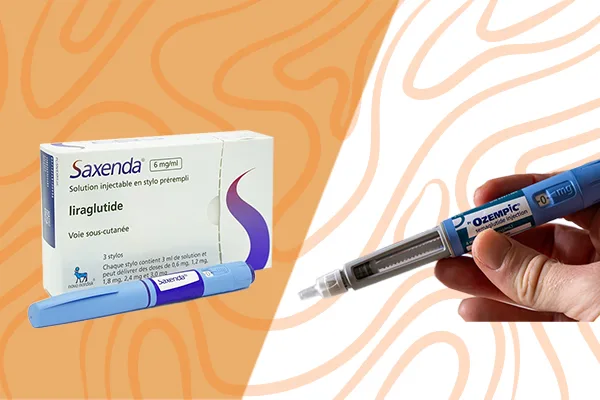Is Saxenda for Weight Loss Effective and Safe for You?
Saxenda for weight loss is an FDA-approved daily injection that helps manage obesity by reducing appetite through GLP-1 hormone mimicry. It’s most effective when paired with diet and exercise. Key points:
Average weight loss: 8–12% over several months
Dosage: Starts at 0.6 mg/day, increasing to 3.0 mg/day
Benefits: Appetite control, sustained weight loss, better energy
Side effects: Nausea, diarrhea, rare serious risks like pancreatitis
Best for: Adults/adolescents with obesity or weight-related issues
Consult your doctor to see if Saxenda is a fit for your weight loss plan.
Obesity is a growing public health concern, contributing to conditions such as diabetes, cardiovascular disease, and metabolic disorders. Traditional weight loss methods, such as diet and exercise, often do not yield sustainable results for everyone. This has led to the development of pharmacological interventions like Saxenda (liraglutide), a glucagon-like peptide-1 (GLP-1) receptor agonist that has gained popularity for its effectiveness in weight loss.
Approved by the U.S. Food and Drug Administration (FDA) in 2014, Saxenda is designed for adults with obesity (BMI ≥30) or overweight individuals (BMI ≥27) who have weight-related comorbidities. This article explores how to lose weight fast with Saxenda, covering its mechanism, benefits, dosage, side effects, and scientific backing.
What is Saxenda?
Saxenda is an injectable medication that mimics the GLP-1 hormone, which plays a crucial role in regulating appetite and food intake. By activating GLP-1 receptors in the brain, Saxenda increases feelings of fullness while reducing hunger, leading to a lower caloric intake. The average weight loss on Saxenda injection varies by individual, but clinical trials have demonstrated its efficacy in promoting weight loss when combined with a reduced-calorie diet and regular physical activity (Pi-Sunyer et al., 2015).
How Saxenda Works for Weight Loss
Saxenda injection affects the GLP-1 receptors. It stimulates insulin secretion, delays gastric emptying, and reduces appetite. These mechanisms contribute to decreased caloric intake and improved metabolic regulation. Therefore, it is an effective tool for weight management. How to use Saxenda for weight loss? The short answer is that it works best when combined with lifestyle changes, including diet and exercise (Mehta et al., 2017). We will elaborate the details in this artilce.

Clinical Evidence on Saxenda’s Effectiveness
The average weight loss on Saxenda varies depending on individual factors like diet, exercise, and consistency of the treatment. Clinical studies show that patients using Saxenda injection along with a reduced-calorie diet and regular physical activity can lose 8-12% of their body weight over several months. Many users report noticeable results within the first 12 weeks. However, weight loss progress may differ for each person. For the best outcomes, it is essential to follow a healthy lifestyle alongside using Saxenda. Always consult your healthcare provider to determine if Saxenda is right for your weight loss journey.
Weight Loss Results in Adults
Several studies have examined the average weight loss on Saxenda. A 56-week, randomized, double-blind, placebo-controlled trial with 3,731 overweight or obese adults found that Saxenda injections led to an average weight loss of 8.4 kg (18.5 lbs), compared to 2.8 kg (6.2 lbs) in the placebo group (Pi-Sunyer et al., 2015). Additionally, 63.2% of those treated with Saxenda achieved at least a 5% weight reduction, compared to 27.1% in the placebo group.
Long-Term Weight Maintenance
A three-year study on individuals with prediabetes demonstrated that more than half of the participants who used Saxenda maintained clinically significant weight loss, reducing the likelihood of developing type 2 diabetes (Davies et al., 2015).
Saxenda for Adolescents
A study that evaluated Saxenda in obese adolescents (ages 12-17) showed that those receiving Saxenda experienced a significantly greater BMI reduction compared to the placebo group. This underscores its potential for managing obesity in younger populations (Weghuber et al., 2020).

How to Use Saxenda
Saxenda Dosage and Administration
Saxenda dosage for weight loss gradually increases over five weeks to minimize side effects. So, when you’re starting Saxenda, you should always begin with 0.6 mg per day.
| Week | Dosage (mg/day) |
| 1 | 0.6 |
| 2 | 1.2 |
| 3 | 1.8 |
| 4 | 2.4 |
| 5+ | 3.0 (maintenance) |
When to Take Saxenda?
Saxenda can be taken at any time of day, with or without food. It is best to take it at the same time each day to maximize its effectiveness.
How Long Does a Pen Last?
A single Saxenda pen typically lasts about one month at the maintenance dose of 3 mg/day. Keep in mind that you should keep track of your medication supply to avoid interruptions in treatment.

Potential Side Effects of Saxenda
Saxenda is generally well-tolerated, but some individuals experience side effects. Saxenda weight loss side effects include:
- Nausea
- Vomiting
- Diarrhea
- Constipation
- Injection site reactions
In most cases, these symptoms diminish over time as the body adapts to the medication (Kapitza et al., 2015).
Serious Side Effects
- Pancreatitis: Some cases of acute pancreatitis have been reported in patients using the Saxenda injection (Marso et al., 2016).
- Thyroid Tumors: GLP-1 receptor agonists have been linked to thyroid C-cell tumors in animal studies, although it was not confirmed in a human study.
- Gallbladder Disease: A small percentage of patients develop gallstones or cholecystitis.
Patients experiencing severe abdominal pain, persistent nausea, or difficulty swallowing should seek immediate medical attention.
Comparing Saxenda with Other Weight Loss Medications
Saxenda vs. Ozempic
Semaglutide drugs (Saxenda and Ozempic) both belong to the GLP-1 receptor agonist class. Saxenda requires daily injections. However, Ozempic is a once-weekly injection. They are primarily indicated for type 2 diabetes but also promote significant weight loss. Studies suggest that Ozempic may lead to slightly greater weight reduction than Saxenda (Wilding et al., 2021).

Saxenda vs. Wegovy
Wegovy (semaglutide 2.4 mg) is another GLP-1 receptor agonist approved for weight management. Clinical trials have demonstrated that Wegovy produces better weight loss outcomes compared to Saxenda (Rubino et al., 2021). However, some patients may prefer Saxenda due to its established safety profile and long-term clinical data.
Saxenda vs. Mounjaro
These two injectable medications, Saxenda (liraglutide) and Mounjaro (tirzepatide), play a significant role in weight management. Saxenda, a GLP-1 receptor agonist, requires daily injections. Mounjaro, a dual GIP and GLP-1 receptor agonist, is administered weekly. Clinical trials have shown that tirzepatide leads to more significant weight loss compared to liraglutide. For example, the SURPASS-2 trial reported an average weight reduction of 15-22% with tirzepatide, outperforming liraglutide. However, individual responses may vary, and the choice between these weight loss medications should be guided by a healthcare professional.
Saxenda Before and After Weight Loss Reviews
Saxenda weight loss reviews from users highlight both benefits and challenges. Many users report significant weight loss, improved energy levels, and better control over food cravings. However, some experience side effects like nausea and the inconvenience of daily injections.

Who Should Avoid Saxenda for Weight Loss?
Saxenda is not suitable for:
- Individuals with a personal or family history of medullary thyroid carcinoma or multiple endocrine neoplasia syndrome type 2.
- Patients with a history of pancreatitis.
- Pregnant or breastfeeding women.
- Those with severe gastrointestinal disorders.
Conclusion: Saxenda for Weight Loss
Saxenda has proven to be an effective pharmacological option for weight loss, particularly for individuals struggling with obesity or weight-related conditions. It’s also among the weight loss drugs used by celebrities. By mimicking the GLP-1 hormone, the Saxenda injection helps control appetite and caloric intake, leading to sustainable weight loss when combined with lifestyle changes. Clinical studies support its efficacy, with significant weight reduction observed in both adults and adolescents.
However, like any medication, Saxenda is not without risks. Patients should discuss potential benefits and side effects with their healthcare providers before starting treatment. With proper medical supervision from our experts at elegant hoopoe and consistency in a comprehensive weight management plan, Saxenda can be a valuable tool in the fight against obesity.






